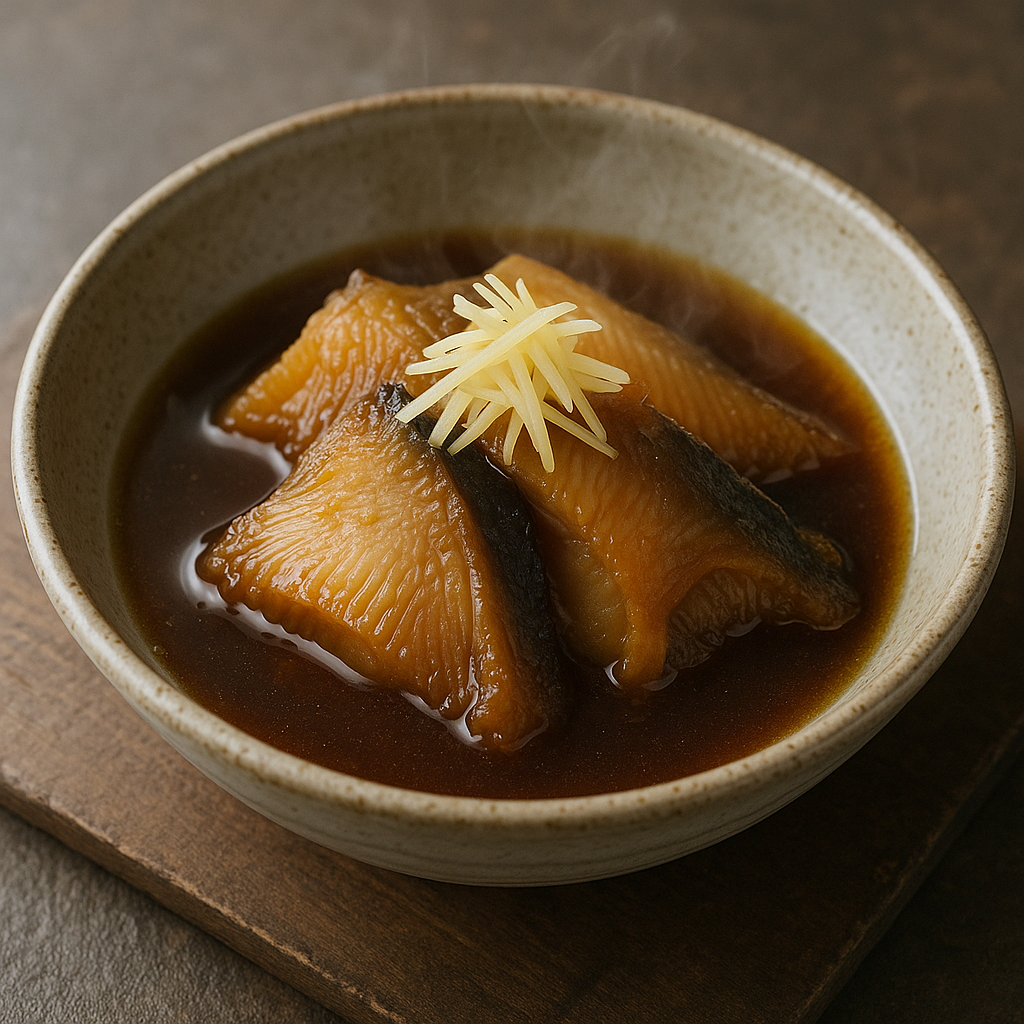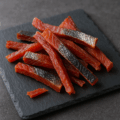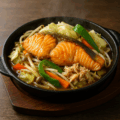カスベの煮付けの特徴
北海道の冬の味覚
カスベ(エイの仲間の魚)は、北海道で食べられてきた魚で、特に冬に美味しいとされます。独特のゼラチン質と軟骨のコリコリとした食感が特徴です。
甘辛い煮汁がよく合う
醤油・みりん・砂糖を使った甘辛い煮汁で煮付けにすることで、カスベの旨味と食感が引き立ちます。
家庭料理から居酒屋メニューまで
家庭料理として親しまれるだけでなく、居酒屋や郷土料理店でも提供され、北海道を代表する煮魚料理のひとつです。
カスベの煮付けのレシピ
材料(4人分)
- カスベ(切り身) … 400g
- 生姜 … 1片(薄切り)
- 醤油 … 大さじ3
- みりん … 大さじ2
- 砂糖 … 大さじ1
- 酒 … 大さじ2
- 水 … 200ml
作り方
- カスベを流水で洗い、水気を拭き取る。
- 鍋に水・酒・生姜・調味料を入れて煮立てる。
- 煮汁が沸いたらカスベを加え、落し蓋をして中火で煮る。
- 10〜15分ほど煮て、煮汁が少なくなったら完成。
シェフのワンポイントアドバイス
兎に角、エイの鮮度が命の為、手に入らない人は素直に冷凍物かおとりよせで既製品を買うのが無難ですね。
煮付ける前に熱湯をかけて霜降りすると、臭みが取れて仕上がりが良くなります。 ゼラチン質を活かすために煮込みすぎず、程よい火加減で仕上げるのがポイントです。
カスベの煮付けの栄養価(1人分の目安)
- エネルギー:約200〜250 kcal
- たんぱく質:18〜22 g
- 脂質:5〜8 g
- 炭水化物:5〜8 g(煮汁由来)
- コラーゲン(ゼラチン質由来)
- カルシウム(軟骨由来)
低脂肪・高たんぱくで、コラーゲンやカルシウムも豊富なため、美容や骨の健康にも良い料理です。
カスベの煮付けの歴史
庶民の味として
かつては安価で手に入りやすい魚として、北海道の庶民に広く食べられてきました。
保存技術の発達と普及
冷凍・流通技術の発展により、現在では道外にも出荷され、北海道の冬の味覚として知られるようになりました。
郷土料理としての定着
現在では居酒屋や郷土料理店でも提供され、北海道ならではの家庭料理から観光客向けの料理へと広まりました。
English Version
Features of Simmered Kasube (Ray Fish)
A Winter Taste of Hokkaido
Kasube, a type of ray fish, has long been eaten in Hokkaido, and is considered especially delicious in winter. Its unique gelatinous texture and crunchy cartilage are its defining characteristics.
Perfect with Sweet-Savory Broth
Simmering the fish in a sweet-savory broth made with soy sauce, mirin, and sugar enhances the flavor and highlights the distinctive texture of kasube.
From Home Cooking to Izakaya Menus
Once a common household dish, simmered kasube is now also served in izakaya pubs and regional restaurants, making it one of Hokkaido’s signature simmered fish dishes.
Recipe
Ingredients (for 4 servings)
- Kasube (ray fish fillet) … 400g
- Ginger … 1 piece (thinly sliced)
- Soy sauce … 3 tbsp
- Mirin … 2 tbsp
- Sugar … 1 tbsp
- Sake … 2 tbsp
- Water … 200ml
Instructions
- Wash the kasube under running water and pat dry.
- In a pot, bring water, sake, ginger, and seasonings to a boil.
- Once the broth is boiling, add the kasube, cover with a drop lid, and simmer over medium heat.
- Simmer for 10–15 minutes until the broth is reduced and the fish is flavored.
Chef’s Tip
Freshness is crucial when it comes to ray fish. If fresh kasube is hard to obtain, it’s safer to buy frozen or pre-prepared products online. Blanching the fish with hot water before simmering removes odors and improves the finish. To preserve the gelatinous texture, avoid overcooking and keep the heat moderate.
Nutritional Value (per serving, approx.)
- Calories: 200–250 kcal
- Protein: 18–22 g
- Fat: 5–8 g
- Carbohydrates: 5–8 g (from the broth)
- Collagen (from gelatinous parts)
- Calcium (from cartilage)
Low in fat and high in protein, kasube is also rich in collagen and calcium, making it beneficial for beauty and bone health.
Historical Background
A Dish of the Common People
Kasube was once an inexpensive and readily available fish, eaten widely by ordinary households in Hokkaido.
Spread with Preservation Technology
With the development of freezing and distribution technology, kasube is now shipped outside of Hokkaido and is recognized as a winter delicacy.
Established as a Regional Cuisine
Today, simmered kasube is not only a staple of home cooking but is also served at izakaya and local restaurants, making the leap from household fare to a tourist attraction dish.



何でも質問してください!